 The Salmon River
The Salmon River
Story and Photos by Ed Mitchell
South of Marlborough, Connecticut, south and west, a river runs. It is not a large river, yet it holds a large place in many an angler’s heart. They know these bright waters, and wade its riffles and runs, dreaming of trout dancing on a fly line.
This is the Salmon River. Born from the nexus of the Blackledge and Jeremy Rivers, it journeys roughly ten miles through the Salmon River State Forest, meeting the mighty Connecticut a mile north of the Route 82 bridge. The Salmon contains a Trout Management Area (TMA), inside of which is roughly a mile-long fly-fishing-only (FFO) stretch. That stretch is the focus of this article.
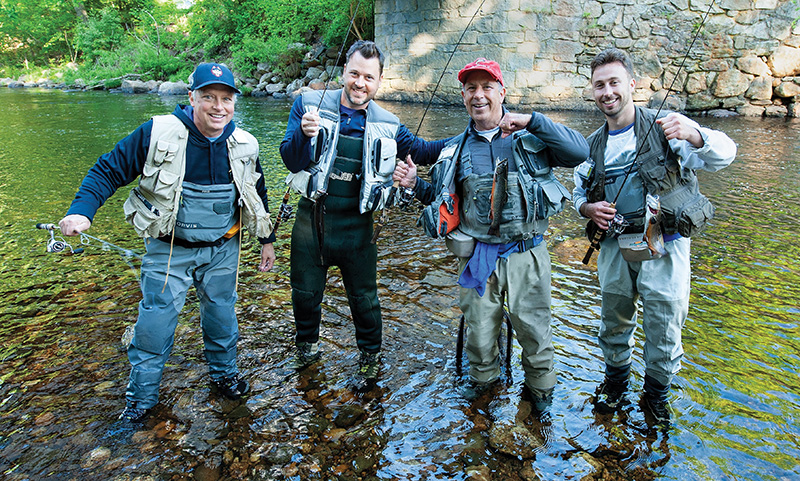
These avid anglers believe in catch and release. These fish was returned to the water seconds after this photo was taken.
Perhaps the easiest way to reach the Salmon is to locate where it passes under Route 16, about five miles west of Colchester. Turn here onto River Road, and immediately ahead the Comstock Covered Bridge appears, assuring your arrival. You are now at the beginning of the Salmon River’s TMA which extends from Route 16 several miles upstream to junction of the Blackledge and Jeremy. Be aware that both the TMA and the FFO area are hook and release only from September 1st until 6:00 a.m. on the second Saturday of April. Then until August 31st the daily creel limit is two trout with a nine-inch minimum length.
The FFO stretch is a popular destination, and rare is the day you find yourself alone here, but even if you do, you’ll have wildlife as your neighbor. Eagles and osprey glide overhead, fast and fleet kingfisher dart, while blue heron watch nearby. And as dark descends, an owl may call to you from the forest edges. In all, a touch of Eden.
Weather permitting, the state stocks the FFO section as early as mid-February. Seeking to shed cabin fever, anglers take advantage, arriving on the water by mid-March. This early season fishing is highly rewarding, ten fish days are not uncommon. Remember the river is catch and release only at this time of year. Additional stocking follows on a regular basis. The size and number of trout are generous, some trout reaching fifteen inches or more. Sweeting the mix, the state adds a few brood stock trout from the hatchery. These fish can go upwards of five pounds, surprising many a happy angler. All of this ensures fine fishing up until about mid-June. After that the Salmon River is often quite low and warm. At this point it is best to rest the trout.
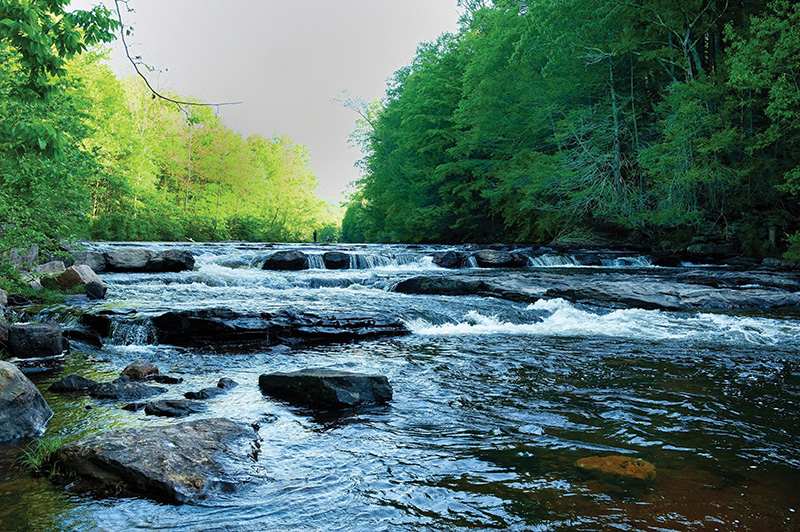
The spillway marking the downstream end of the fly-fishing area.
To locate the lower reach of the FFO section, drive up River Road from Route 16 about half a mile. The road is quite narrow; please go slowly. Right after a sharp bend, a lone house appears on your right. Just beyond it, hidden in the trees, there is a broken-down spillway marking the downstream end of the FFO waters. To properly fish this spot, proceed a short distance farther until you see Dickerson Creek running under the road. Park and follow the creek until it joins the Salmon.
Below, the broad, slow-moving pool ends at the spillway. Four or five weight rods with floating lines are a fine choice—as they are throughout the FFO area. While dry fly-fishing is a bit limited in the FFO section, as we move into May this pool has promise, with the best dry action typically in the lower half of the pool. Wade and cast quietly; these fish are wary. And be sure to cover both banks and fish your fly right to the very edge of the spillway.
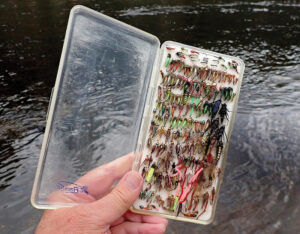
A look in my box of nymphs.
Above Dickerson Creek, the Salmon has a short rocky run. Don’t pass it by. A fair number of fish haunt this pocket water. Streamers may work, but soft hackles and wets are usually a more effective choice. Once you reach the upper few yards of this run, however, I suggest you switch to a nymph. Directly upstream of where you stand is the most fished spot in the FFO section—the Handicap Access Pool. This is a deeper pool, fished from shore, containing excellent holding water even for larger fish. In early season, swinging a Woolly Bugger or a White Zonker is strong medicine. If you are itching to try something different, however, veterans of the Salmon River prefer a Hornberg, a streamer created over a hundred years ago. Cast it quartering upstream, allowing it to land lightly on the water. It should float for a moment permitting you to briefly fish it as a dry. Then yank it under, and strip it back like any other streamer. It might surprise you.
The Handicap Pool is another place where dry fly action pops up. By far the most common hatches here are Caddis and Midges. Expect the fish to rise along the far bank where there is a touch of shade. There is always a rise or two right at the tail of the pool as well. Because of varying currents, getting a good drift can be tricky. So, you’ll need to mend your line. The deadliest way by far to fish this pool is with nymphs. Drift your offering deep and slow, as near the bottom as possible. And be very patient, cover each spot several times before giving up. During periods of higher water, I suggest a size 14# Copper Johns or a Bead-head Peasant Tail, although many nymphs work. As the water lowers into May, however, tiny nymphs take over. My personal favorite is a size 18# Zebra Midge. Don’t be surprised if you see some anglers going even smaller.
Plenty of good pocket water lies above the Handicap Pool. It extends for quite a distance and gets less fishing pressure. As a result, you are pretty much guaranteed a spot to fish even on the busiest days, and the fish are a tad less spooky. The first 75 yards is fished from shore. Roll casting a wet fly would be my preferred tactic. Farther upstream, beyond the overhead power lines, more good water awaits. On a spring day, the sun on my shoulder, I like to wade these waters, swinging a team of soft hackles across current. An alternative tactic is to drop a streamer in the dark pockets behind boulders. Fish it on a short line while staying ever alert—strikes are instantaneous.
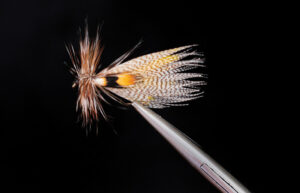
Hornberg streamer.
Continuing upstream, the banks begin to rise steeply on both sides, providing a good deal of shade even into midmorning. Eventually you’ll reach the remnants of an old bridge. Only the abutments remain, the bridge long gone, although I remember as a wide-eyed lad driving a Chevy Impala over it. This spot is referred to as the Day Pond Bridge Pool, marking the upstream end of the FFO section. You can also reach this pool by following River Road until it turns to dirt. Look for a small pull off at the abutments. Because of the steep banks, climbing down here is tricky. Take care.
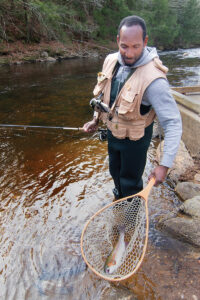
Here an angler lands a nice fat rainbow trout.
Like the Handicap Pool, this pool has enough depth for bigger fish but sees far fewer anglers. I recommend you cover it well. The center run is productive, but don’t neglect the slower currents along the shore. On the far bank Day Pond Creek trickles in. Be sure to cover where this tiny tributary joins the river. Big fish like to hang right here. Long ago, it rewarded me with a four-pound brown. Not a wild fish, mind you, but a brood stock brown from the hatchery. Believe me, the memory lingers.
In closing allow me to mention that the Salmon River was once part of the now defunct Atlantic Salmon Restoration Program. So, there are posted signs asking you to return any salmon immediately to the river. The chances of you catching an adult or parr salmon are slim, but if you encounter one please release it.
Ed Mitchell is the author of four books on fly-fishing and has written for many magazines. He has over 40 years of experience in both fresh and saltwater fly-fishing.
